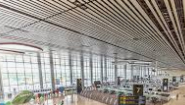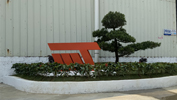The Role of Suspended Perforated Metal Mesh Ceiling Panels in Sustainable Building Design
Author:Jayminton Time:2024-08-21
As the focus on sustainable building design intensifies, architects and designers are increasingly turning to materials that support environmental goals while also delivering on aesthetics and functionality.
Suspended perforated metal Mesh Ceiling Panels are at the forefront of this trend, offering a sustainable solution that meets the demands of modern construction and design.

One of the primary reasons for the sustainability of these Ceiling Panels is their material composition. Metals such as aluminum and steel, commonly used in the production of these panels, are highly recyclable. In fact, many of these panels are made from recycled materials, which significantly reduces the environmental impact of their production.
Moreover, at the end of their life cycle, these panels can be fully recycled, contributing to a circular economy and reducing waste.
The lightweight nature of Suspended Perforated Metal Mesh Ceiling Panels also contributes to their sustainability. Lighter materials require less energy to transport and install, which reduces the overall carbon footprint of a building project.
The reduced weight of the panels places less strain on the building structure, which can lead to a decrease in the amount of construction materials required, further lowering the environmental impact.
Another key aspect of sustainability is energy efficiency, and Suspended Perforated Metal Mesh Ceiling Panels excel in this area as well. The perforated design allows for the penetration of natural light, reducing the need for artificial lighting during the day. This not only lowers energy consumption but also creates a more pleasant and productive environment for occupants.
The open mesh structure facilitates air circulation, which can enhance the efficiency of HVAC systems and contribute to overall energy savings.

 S1 Clip-in Metal ceiling System
S1 Clip-in Metal ceiling System JMT-L4.2 U-Baffle System
JMT-L4.2 U-Baffle System JMT Aluminum Wall Cladding
JMT Aluminum Wall Cladding Aluminum Honeycomb Panel
Aluminum Honeycomb Panel Air-Condenser Cover
Air-Condenser Cover Metal Heat Cover
Metal Heat Cover Singapore Changi Airport T2 Arrival
Singapore Changi Airport T2 Arrival Australia Marvrl Stadium City Edge
Australia Marvrl Stadium City Edge Enterprise Information Announcement
Enterprise Information Announcement Construction Industry Solutions
Construction Industry Solutions About Jayminton
About Jayminton Contact US
Contact US